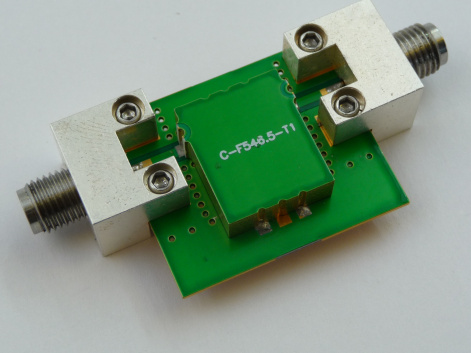A bandpass multiconductor microwave filter with high frequency selectivity has been created
1 February 2022 г.

The most important devices of modern radio engineering systems for transmitting, receiving, and processing signals are band-pass filters. They determine not only the quality of radio equipment, but also its dimensions, and even the price. Therefore, it is important to develop new designs of miniature filters with high selectivity and low cost for series production. One of the promising candidates for such devices is a multiconductor stripline resonator. However, traditional designs do not allow high filter selectivity to be achieved.
A team of Krasnoyarsk scientists, which included researchers from the Federal Research Center "Krasnoyarsk Science Center of the Siberian Branch of the Russian Academy of Sciences", together with the industrial partner JSC "SPE "Radiosvyaz", developed a new monolithic miniature bandpass filter. The filter has a wide high-frequency stopband. Its design including multi-conductor strip resonators provides small size and high selectivity to the received signals.
The filter is designed on the basis of multiconductor stripline resonators, which have record-breaking small dimensions among electrodynamic resonators. Each of the resonators is formed by six strip conductors located one above another and separated by thin dielectric layers. As the authors note, the fundamental difference between this design and the already known ones is the connection of non-adjacent conductors with metalized cylindrical holes. Due to this, the frequency difference of the first two resonances increases many times. As a result, the noise suppression of the filter is improved. The width of all the strip conductors is one millimeter, their length is about 13 millimeters, and the total length of the resonator is 15 millimeters. The weight of the device is smaller than 2 grams.
“We solved the problem of improving the frequency selectivity of filters based on multi-wire resonators by connecting odd conductors near their free ends in a specific manner. The new miniature monolithic design of the bandpass filter is made using multilayer printed circuit board technology. This made it possible to reduce the losses in the passband of the filter. In addition, the technology provides high-precision printing of conductors in multilayer structures with the possibility of simultaneously manufacturing many devices on a large-area multilayer board. This would greatly reduce the cost of filters in series production as compared to other miniaturization technologies. Moreover, the good characteristics of the developed filter design make it suitable for use in various radio communication systems, radar, radio navigation, and special radio equipment,” said Boris Belyaev, Doctor of Technical Sciences, Professor, Head of the Laboratory at the L.V. Kirensky Institute of Physics FRC KSC SB RAS.
____________________________________________
The study was supported by the Ministry of Science and Higher Education of the Russian Federation (Project No. 075-11-2019-078).
Share:
